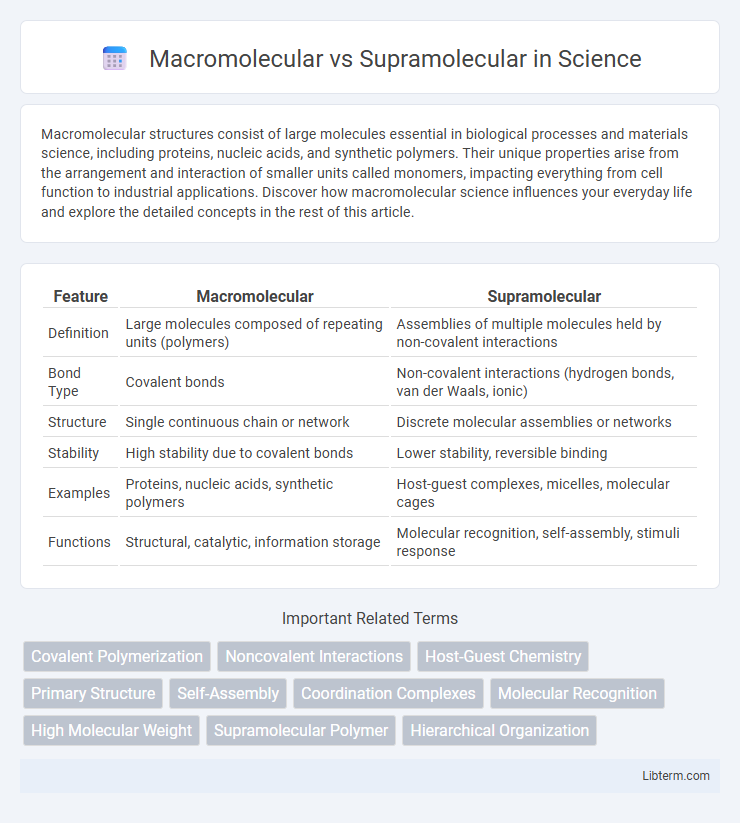Macromolecular structures consist of large molecules essential in biological processes and materials science, including proteins, nucleic acids, and synthetic polymers. Their unique properties arise from the arrangement and interaction of smaller units called monomers, impacting everything from cell function to industrial applications. Discover how macromolecular science influences your everyday life and explore the detailed concepts in the rest of this article.
Table of Comparison
| Feature | Macromolecular | Supramolecular |
|---|---|---|
| Definition | Large molecules composed of repeating units (polymers) | Assemblies of multiple molecules held by non-covalent interactions |
| Bond Type | Covalent bonds | Non-covalent interactions (hydrogen bonds, van der Waals, ionic) |
| Structure | Single continuous chain or network | Discrete molecular assemblies or networks |
| Stability | High stability due to covalent bonds | Lower stability, reversible binding |
| Examples | Proteins, nucleic acids, synthetic polymers | Host-guest complexes, micelles, molecular cages |
| Functions | Structural, catalytic, information storage | Molecular recognition, self-assembly, stimuli response |
Introduction to Macromolecular and Supramolecular Chemistry
Macromolecular chemistry involves the study of large molecules composed of repeating structural units, such as polymers, which exhibit unique physical and chemical properties due to their high molecular weight and chain architecture. Supramolecular chemistry focuses on the complex structures formed by the reversible and non-covalent interactions between molecules, including hydrogen bonding, metal coordination, and van der Waals forces, enabling the design of highly organized systems with specific functions. Both fields intersect in exploring molecular assemblies and materials with applications in nanotechnology, drug delivery, and functional materials design.
Definitions: Macromolecules vs. Supramolecules
Macromolecules are large molecules composed of thousands of atoms covalently bonded to form polymers such as proteins, nucleic acids, and synthetic plastics. Supramolecules consist of assemblies of two or more molecules held together by non-covalent interactions like hydrogen bonding, van der Waals forces, and metal coordination. The fundamental difference lies in macromolecules being single covalent entities, while supramolecules are dynamic structures formed through reversible intermolecular forces.
Structural Differences Between Macromolecular and Supramolecular Systems
Macromolecular systems consist of covalently bonded large molecules with well-defined, stable structures, such as polymers and proteins, providing rigidity and permanence. Supramolecular systems are assemblies of molecules held together by non-covalent interactions like hydrogen bonding, van der Waals forces, and ionic interactions, allowing dynamic and reversible structures. This fundamental difference in bonding type results in macromolecules having fixed architectures, whereas supramolecular complexes exhibit adaptable and responsive configurations.
Synthesis Approaches: Macromolecular vs. Supramolecular Assembly
Macromolecular synthesis typically involves covalent polymerization techniques such as step-growth or chain-growth polymerization to form large, stable molecules with defined molecular weights. Supramolecular assembly relies on non-covalent interactions including hydrogen bonding, p-p stacking, and metal coordination to create dynamic, reversible structures with tunable properties. These contrasting approaches enable precise control over molecular architecture in macromolecules versus adaptive functionality in supramolecular systems.
Types of Interactions: Covalent vs. Non-Covalent Forces
Macromolecular structures are primarily stabilized by covalent bonds, which provide strong, permanent connections between atoms within a molecule, resulting in high structural integrity and durability. Supramolecular assemblies rely on non-covalent interactions such as hydrogen bonding, van der Waals forces, electrostatic interactions, and p-p stacking, allowing dynamic, reversible, and highly specific molecular recognition processes. The distinction between covalent and non-covalent forces directly influences the stability, functionality, and responsiveness of macromolecular versus supramolecular systems.
Functional Properties and Applications
Macromolecular systems consist of large, covalently bonded molecules such as polymers with inherent mechanical strength, thermal stability, and chemical resistance, making them essential in manufacturing plastics, fibers, and biomedical devices. Supramolecular systems rely on non-covalent interactions like hydrogen bonding and van der Waals forces, providing dynamic and reversible properties useful in drug delivery, self-healing materials, and molecular recognition. The tunable and stimuli-responsive nature of supramolecular assemblies contrasts with the robust, permanent structure of macromolecules, allowing applications in stimuli-responsive coatings and adaptive materials.
Stability and Responsiveness in Different Environments
Macromolecular structures exhibit high intrinsic stability due to covalent bonding within polymer chains, making them less susceptible to environmental changes such as pH or temperature fluctuations. Supramolecular assemblies rely on non-covalent interactions like hydrogen bonding and van der Waals forces, which confer greater environmental responsiveness but lower overall stability compared to macromolecules. This dynamic nature allows supramolecular systems to reversibly adapt their conformation and function in response to stimuli, offering advantages in applications requiring smart material behavior.
Advantages and Limitations of Macromolecular and Supramolecular Architectures
Macromolecular architectures offer high stability and durability due to covalent bonding, enabling robust material properties and long-lasting performance in applications such as polymers and biomaterials. Supramolecular architectures, formed through non-covalent interactions, provide dynamic self-assembly, reversible binding, and tunable functionality, which are advantageous for stimuli-responsive systems and adaptive materials. However, macromolecular systems often lack flexibility and self-healing capabilities, while supramolecular assemblies can suffer from lower structural integrity and sensitivity to environmental conditions.
Recent Advances and Emerging Trends
Recent advances in macromolecular chemistry emphasize controlled polymerization techniques and precision synthesis enabling tailored molecular architectures, while supramolecular chemistry trends focus on dynamic self-assembly processes and stimuli-responsive materials. Emerging research integrates machine learning with molecular design to predict and optimize complex macromolecular and supramolecular interactions. Innovative applications in drug delivery, smart materials, and molecular electronics highlight the convergence of these fields, driving the development of multifunctional and adaptive systems.
Future Perspectives in Macromolecular and Supramolecular Science
Advancements in macromolecular and supramolecular science are driving the development of smart materials and responsive systems with applications in drug delivery, nanotechnology, and sustainable energy. The integration of AI and machine learning enhances the design and synthesis of complex polymers and molecular assemblies, optimizing their functionality and efficiency. Future perspectives emphasize the convergence of macromolecular precision and supramolecular adaptability to create highly tunable and multifunctional materials for next-generation technologies.
Macromolecular Infographic

 libterm.com
libterm.com